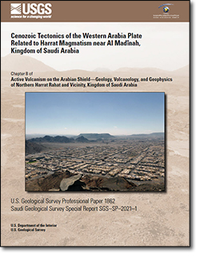Cenozoic Tectonics of the Western Arabia Plate Related to Harrat Magmatism near Al Madīnah, Kingdom of Saudi Arabia
Links
- Document: Report (2.95 MB pdf)
- Larger Work: This publication is Chapter B of Active volcanism on the Arabian Shield—Geology, volcanology, and geophysics of northern Harrat Rahat and vicinity, Kingdom of Saudi Arabia
- Download citation as: RIS | Dublin Core
Abstract
Suggested Citation
Calvert, A.T., and Sisson, T.W., 2023, Cenozoic tectonics of the western Arabia Plate related to harrat magmatism near Al Madīnah, Kingdom of Saudi Arabia, chap. B of Sisson, T.W., Calvert, A.T., and Mooney, W.D., eds., Active volcanism on the Arabian Shield—Geology, volcanology, and geophysics of northern Harrat Rahat and vicinity, Kingdom of Saudi Arabia: U.S. Geological Survey Professional Paper 1862 [also released as Saudi Geological Survey Special Report SGS–SP–2021–1], 28 p., https://doi.org/10.3133/pp1862B.
ISSN: 2330-7102 (online)
ISSN: 1044-9612 (print)
Study Area
Table of Contents
- Abstract
- Introduction
- Importance and Complexities of Red Sea Tectonics
- Characteristics of Arabian Peninsula Harrats
- Geologic Setting
- New 40Ar/39Ar Constraints on Structures in and Adjacent to Harrat Rahat
- Oligocene to Present Plate Tectonic Model
- Red Sea Pure-Shear versus Simple-Shear Tectonic Models
- Discussion and Summary
- Acknowledgments
- References Cited
- Appendix 1. 40Ar/39Ar Analysis Results
| Publication type | Report |
|---|---|
| Publication Subtype | USGS Numbered Series |
| Title | Cenozoic tectonics of the western Arabia Plate related to harrat magmatism near Al Madīnah, Kingdom of Saudi Arabia |
| Series title | Professional Paper |
| Series number | 1862 |
| Chapter | B |
| DOI | 10.3133/pp1862B |
| Publication Date | December 29, 2023 |
| Year Published | 2023 |
| Language | English |
| Publisher | U.S. Geological Survey |
| Publisher location | Reston, VA |
| Contributing office(s) | Geology, Minerals, Energy, and Geophysics Science Center, Volcano Science Center |
| Description | v, 28 p. |
| Country | Kingdom of Saudi Arabia |
| Online Only (Y/N) | N |
| Additional Online Files (Y/N) | N |


